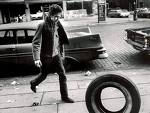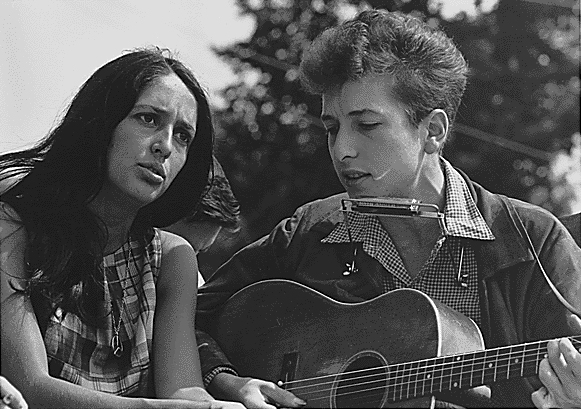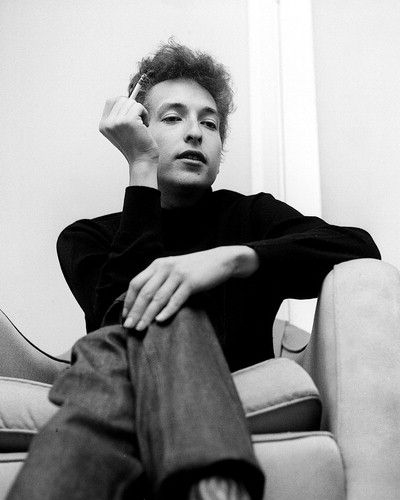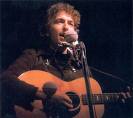Second Album: The Freeewheelin' Bob Dylan
Recorded April 1962-April 1963

See details here
All songs by Bob Dylan, except where noted:
1. "Blowin' in the Wind" – 2:48
2. "Girl from the North Country" – 3:22
3. "Masters of War" – 4:34
4. "Down the Highway" – 3:27
5. "Bob Dylan's Blues" – 2:23
6. "A Hard Rain's a-Gonna Fall" – 6:55
7. "Don't Think Twice, It's All Right" – 3:40
8. "Bob Dylan's Dream" – 5:03
9. "Oxford Town" – 1:50
10. "Talkin' World War III Blues" – 6:28
11. "Corrina, Corrina" (Traditional) – 2:44
12. "Honey, Just Allow Me One More Chance" (Dylan, Henry Thomas) – 2:01
13. "I Shall Be Free" – 4:49
For Lyrics see here.
In-class Lyrics

Outakes and Related Songs:
# 1. Baby Please Don't Go (Studio Outtake)
#
#
# 2. Corrina, Corrina (Alternate Solo Version)(Alternate Take)
#
#
# 3. The Death of Emmett Till (Studio Outtake)
#
#
# 4. Mixed Up Confusion (Rare Single Version)
#
#
# 5. (I Heard That) Lonesome Whistle (Studio Outtake)
#
#
# 6. Talkin' John Birch Paranoid Blues
#
#
# 7. Milkcow's Calf Blues (Take 3)
#
#
# 8. That's Alright Mama (Take 1, Studio Outtake)
#
#
# 9. Solid Road (Rocks and Gravel) (Alternate Solo Version)
#
#
# 10. Going to New Orleans (Studio Outtake)
#
#
# 11. Let Me Die in My Footsteps (Unedited with Extra Verse)
#
#
# 12. The Ballad of Hollis Brown (Studio Outtake)
#
#
# 13. Wichita (Take 2, Studio Outtake)
#
#
# 14. Sally Girl (Take 4, Studio Outtake)
#
#
# 15. What'cha Gonna Do? (Studio Outtake)
#
#
# 16. Mixed Up Confusion (Alternate Version "A")(Alternate Take)
#
#
# 17. Solid Road (Rocks and Gravel)
#
#
# 18. That's Alright Mama (Take 2, Studio Outtake)
#
#
# 19. Mixed Up Confusion (Alternate Version "B")(Alternate Take)
#
#
# 20. Corrina, Corrina (Rare Single Version)
#
#
# 21. Milkcow's Calf Blues (Take 4, Studio Outtake)
#
#
# 22. Wichita (Take 1, Studio Outtake)
#
#
# 23. What'cha Gonna Do? (Studio Outtake)
#
#
# 24. Baby, I'm in the Mood for You (Alternate Version)
#
#
# 25. Sally Girl (Studio Outtake)
Liner Notes
Produced by John Hammond
from: http://www.bobdylan.com/moderntimes/linernotes/freewheelin.html
Of all the precipitously emergent singers of folk songs in the continuing renascence of that self-assertive tradition, none has equaled Bob Dylan singularity of impact. As Harry Jackson, a cowboy singer and a painter, has exclaimed: "He's so goddamned real it's unbelievable!" The irrepressible reality of Bob Dylan is a compound of spontaneity, candor, slicing wit and an uncommonly perceptive eye and ear for the way many of us constrict our capacity for living while a few of us don't.
Not yet twenty-two at the time of this albums release, Dylan is growing at a swift, experience-hungry rate. In these performances, there is already a marked change from his first album ("Bob Dylan," Columbia CL 1779/CS 8579), and there will surely be many further dimensions of Dylan to come. What makes this collection particularly arresting that it consists in large part of Dylan's own compositions The resurgence of topical folk songs has become a pervasive part of the folk movement among city singers, but few of the young bards so far have demonstrated a knowledge of the difference between well-intentioned pamphleteering and the creation of a valid musical experience. Dylan has. As the highly critical editors of "Little Sandy Review" have noted, "...right now, he is certainly our finest contemporary folk song writer. Nobody else really even comes close."
The details of Dylan's biography were summarized in the notes to his first Columbia album; but to recapitulate briefly, he was born on May 24, 1941, in Duluth, Minnesota. His experience with adjusting himself to new sights and sounds started early. During his first nineteen years, he lived in Gallup, New Mexico: Cheyenne, South Dakota; Sioux Falls, South Dakota; Phillipsburg, Kansas; Hibbing, Minnesota (where he was graduated from high school), and Minneapolis (where he spent a restless six months at the University of Minnesota).
"Everywhere he went," Gil Turner wrote in his article on Dylan in "Sing Out," "his ears were wide open for the music around him. He listened to the blues singers, cowboy singers, pop singers and others -- soaking up music and styles with an uncanny memory and facility for assimilation. Gradually, his own preferences developed and became more , the strongest areas being Negro blues and county music. Among the musicians and singers who influenced him were Hank Williams, Muddy Waters, Jelly Roll Morton, Leadbelly, Mance Lipscomb and Big Joe Williams." And, above all others, Woody Guthrie. At ten he was playing guitar, and by the age of fifteen, Dylan had taught himself piano, harmonica and autoharp.
In February 1961, Dylan came East, primarily to visit Woody Guthrie at the Greystone Hospital in New Jersey. The visits have continued, and Guthrie has expressed approval of Dylan's first album, being particularly fond of the "Song to Woody" in it. By September of 1961, Dylan's singing in Greenwich Village, especially at Gerde's Folk City, had ignited a nucleus of singers and a few critics (notably Bob Shelton of the "New York Times") into exuberant appreciation of his work. Since then, Dylan has inexorably increased the scope of his American audiences while also performing briefly in London and Rome.
The first of Dylan's songs in this set is "Blowin' in the Wind." In 1962, Dylan said of the song's background: "I still say that some of the biggest criminals are those that turn their heads away when they see wrong and they know it's wrong. I'm only 21 years old and I know that there's been too many wars...You people over 21 should know better." All that he prefers to add by way of commentary now is: "The first way to answer these questions in the song is by asking them. But lots of people have to first find the wind." On this track, and except when otherwise noted, Dylan is heard alone-accompanying himself on guitar and harmonica.
"Girl From the North Country" was first conceived by Bob Dylan about three years before he finally wrote it down in December 1962. "That often happens," he explains. "I carry a song in my head for a long time and then it comes bursting out." The song-and Dylan's performance-reflect his particular kind of lyricism. The mood is a fusion of yearning, poignancy and simple appreciation of a beautiful girl. Dylan illuminates all these corners of his vision, but simultaneously retains his bristling sense of self. He's not about to go begging anything from this girl up north.
"Masters of War" startles Dylan himself. "I've never really written anything like that before," he recalls. "I don't sing songs which hope people will die, but I couldn't help it in this one. The song is a sort of striking out, a reaction to the last straw, a feeling of what can you do?" The rage (which is as much anguish as it is anger) is a away of catharsis, a way of getting temporary relief from the heavy feeling of impotence that affects many who cannot understand a civilization which juggles it's own means for oblivion and calls that performance an act toward peace.
"Down the Highway" is a distillation of Dylan's feeling about the blues. "The way I think about the blues," he says, "comes from what I learned from Big Joe Williams. The blues is more than something to sit home and arrange. What made the real blues singers so great is that they were able to state all the problems they had; but at the same time, they were standing outside them and could look at them. And in that way, they had them beat. What's depressing today is that many young singers are trying to get inside the blues, forgetting that those older singers used them to get outside their troubles."
"Bob Dylan's Blues" was composed spontaneously. It's one of what he calls his "really off-the-cuff songs. I start with an idea, and then I feel what follows. Best way I can describe this one is that it's sort of like walking by a side street. You gaze in and walk on."
"A Hard Rain's A-Gonna Fall" represents to Dylan a maturation of his feelings on this subject since the earlier and almost as powerful "Let Me Die in My Footsteps," which is not included here but which was released as a single record by Columbia. Unlike most of his song-writing contemporaries among city singers, Dylan doesn't simply make a polemical point in his compositions. As in this sing about the psychopathology of peace-through-balance-of-terror, Dylan's images are multiply (and sometimes horrifyingly) evocative. As a result, by transmuting his fierce convictions into what can only be called art, Dylan reaches basic emotions which few political statements or extrapolations of statistics have so far been able to touch. Whether a song or a singer can then convert others is something else again.
"Hard Rain," adds Dylan, "is a desperate kind of song." It was written during the Cuban missile crisis of October 1962 when those who allowed themselves to think of the impossible results of the Kennedy-Khrushchev confrontation were chilled by the imminence of oblivion. "Every line in it," says Dylan, "is actually the start of a whole song. But when I wrote it, I thought I wouldn't have enough time alive to write all those songs so I put all I could into this one." Dylan treats "Don't Think Twice, It's All Right" differently from most city singers . "A lot of people," he says, "make it sort of a love song-slow and easy-going. But it isn't a love song. It's a statement that maybe you can say to make yourself feel better. It's as if you were talking to yourself. It's a hard song to sing. I can sing it sometimes, but I ain't that good yet. I don't carry myself yet the way that Big Joe Williams, Woody Guthrie, Leadbelly and Lightnin' Hopkins have carried themselves. I hope to be able to someday, but they're older people. I sometimes am able to do it, but it happens, when it happens, unconsciously. You see, in time, with those old singers, music was a tool-a way to live more, a way to make themselves feel better at certain points. As for me, I can make myself feel better some times, but at other times, it's still hard to go to sleep at night." Dylan's accompaniment on this track includes Bruce Langhorne (guitar), George Barnes (bass guitar), Dick Wellstood (piano), Gene Ramey (bass) and Herb Lovelle (drums).
"Bob Dylan's Dream" is another of his songs which was transported for a time in his mind before being written down. It was initially set off after all-night conversation between Dylan and Oscar Brown, Jr., in Greenwich Village. "Oscar," says Dylan, "is a groovy guy and the idea of this came from what we were talking about." The song slumbered, however, until Dylan went to England in the winter of 1962. There he heard a singer (whose name he recalls as Martin Carthy) perform "Lord Franklin," and that old melody found a new adapted home in "Bob Dylan's Dream." The song is a fond looking back at the easy camaraderie and idealism of the young when they are young. There is also in the "Dream" a wry but sad requiem for the friendships that have evaporated as different routes, geographical and otherwise, are taken.
Of "Oxford Town," Dylan notes with laughter that "it's a banjo tune I play on the guitar." Otherwise, this account of the ordeal of James Meredith speaks grimly for itself.
"Talking World War III Blues" was about half formulated beforehand and half improvised at the recording session itself. The "talking blues" form is tempting to many young singers because it seems so pliable and yet so simple. However, the simpler a form, the more revealing it is of the essence of the performer. There's no place to hide in the talking blues. Because Bob Dylan is so hugely and quixotically himself, he is able to fill all the space the talking blues affords with unmistakable originality. In this piece, for example, he has singularly distilled the way we all wish away our end, thermonuclear or "natural." Or at least, the way we try to.
"Corrina, Corrina" has been considerably changed by Dylan. "I'm not one of those guys who goes around changing songs just for the sake of changing them. But I'd never heard Corrina, Corrina exactly the way it first was, so that this version is the way it came out of me." As he indicates here, Dylan can be tender without being sentimental and his lyricism is laced with unabashed passion. The accompaniment is Dick Wellstood (piano), Howie Collins (guitar), Bruce Langhorne (guitar), Leonard Gaskin (bass) and Herb Lovelle (drums).
"Honey, Just Allow Me One More Chance" was first heard by Dylan from a recording by a now-dead Texas blues singer. Dylan can only remember that his first name was Henry. "What especially stayed with me," says Dylan, "was the plea in the title." Here Dylan distills the buoyant expectancy of the love search.
Unlike some of his contemporaries, Dylan isn't limited to one or two ways of feeling his music. He can be poignant and mocking, angry and exultant, reflective and whoopingly joyful. The final "I Shall Be Free" is another of Dylan's off-the-cuff songs in which he demonstrates the vividness, unpredictability and cutting edge of his wit.
This album, in sum, is the protean Bob Dylan as of the time of the recording. By the next recording, there will be more new songs and insights and experiences. Dylan can't stop searching and looking and reflecting upon what he sees and hears. "Anything I can sing," he observes, "I call a song. Anything I can't sing, I call a poem. Anything I can't sing or anything that's too long to be a poem, I call a novel. But my novels don't have the usual story lines. They're about my feelings at a certain place at a certain time." In addition to his singing and song writing, Dylan is working on three "novels." One is about the week before he came to New York and his initial week in that city. Another is about South Dakota people he knew. And the third is about New York and a trip from New York to New Orleans.
Throughout everything he writes and sings, there is the surge of a young man looking into as many diverse scenes and people as he can find ("Every once in a while I got to ramble around") and of a man looking into himself. "The most important thing I know I learned from Woody Guthrie," says Dylan. "I'm my own person. I've got basic common rights-whether I'm here in this country or any other place. I'll never finish saying everything I feel, but I'll be doing my part to make some sense out of the way we're living, and not living, now. All I'm doing is saying what's on my mind the best way I know how. And whatever else you say about me, everything I do and sing and write comes out of me."
It is this continuing explosion of a total
individual, a young man growing free rather than absurd, that makes Bob
Dylan so powerful and so personal and so important a singer. As you can
hear in these performances.
-- Nat Hentoff

***********************
How should we read and/or listen to Bob Dylan's oeuvre?
Obviously, there are many ways to approach, analyze and reflect critically on Dylan's work. Rock critic Greil Marcus has written one book entirely on a single Dylan song, Like A Rolling Stone, and he also wote another critically acclaimed book on the "Basement Tapes" which was originally called The Invisible Republic--Bob Dylan and The Basement Tapes but is currently published under the title he preferred all along, The Old, Weird America--Bob Dylan and The Basement Tapes. In this book, Marcus locates Dylan's music in the context of deeply American myths and traditions as embodied in folk and country music, and, of course, the blues.
But other critics , like Christopher Ricks and his Visions of Sin or John Hinchey and his Like a Complete Unknown, look at the literary context of Dylan's music noting echoes of poets like Walt Whitman, William Blake, Emily Dickinson, Arthur Rimbaud, T. S. Eliot and John Keats, to name a few. To this list, we should add beat poets and writers like Allen Ginsberg, Jack Kerouac,William Burroughs, and Lawrence Ferlinghetti. These sorts of literary analyses examine Dylan's entire body of work as poetry and subject his songs to "close readings." What close readings accomplish is to take each poem or song entirely on its own internal terms, without becoming too bogged down in either biography or gossip. Poems or songs are looked at line by line, word by word, so we can ask how the words and images connect to each other, or to images within the same or contiguous works. Based on this kind of close reading, the critic can also ask both "why" and "how" questions: why the poet made the choices s/he made, and how the poems or songs actually achieve their effects on the reader. While you may have to guess why a poet makes the choices s/he does, but since you are the reader, you can decide how the song or poem affected you the way it did. That is your call.


Comments
Post a Comment